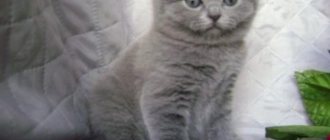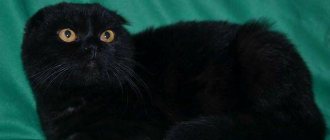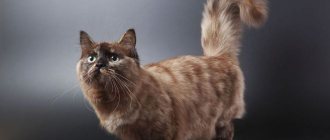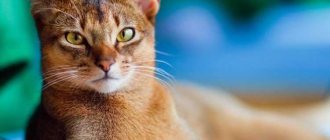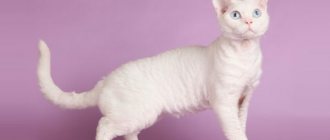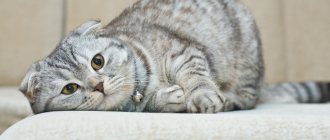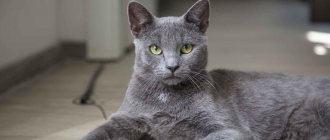Save article:
Scottish cat breeds are divided into several varieties, which have both common features and differences. If you thought that there is only one type of Scottish cat , then this is not so: you can become the owner of a Scottish fold shorthair cat called Scottish Fold, place a Scottish straight-eared shorthaired beauty called Scottish Straight in your home, or bring a longhaired Highland Fold into your family -fold There is only one species left to choose from: the Highland Straight - also a Scottish breed, but straight-eared and long-haired.
These cats are loved not only for their elegant exterior, but also for their interesting character traits. Let us add that the character traits will be equally suitable for all Scots; the types differ only in external beauty.
History of the Scottish Straight cat breed
Scottish Straight cat
Scottish Straight are the same Scottish folds, but with a modified position of the ear. Straight ears do not have a characteristic crease and are set straight, and this, in fact, is the only external sign that distinguishes them from their fold-eared counterparts. Scottish cats are considered one of the youngest cat breeds. The first cat with an unusual, flattened ear shape appeared on a Scottish farm in the early 60s. Surprisingly, the ancestor of modern folds and straights had no pedigree and simply chased mice through the barns of local peasants.
The first official Scottish breeder was an ordinary villager, William Ross, who adopted a kitten from the aforementioned Fold. A few years later, professional breeders also joined the process. At the same time, experts witnessed an interesting phenomenon: in the litters brought by even the most purebred Scottish dogs, babies with erect ears appeared. Of course, no one intended to separate such individuals into a separate breed. And kilometer-long queues did not line up for straight-eared kittens, because against the backdrop of touching folds, they were outright losing. But here nature itself intervened.
Very soon, Scottish breeders noticed that attempts to strengthen and strengthen the lop ears of animals had a negative impact on their health. The mutated gene responsible for the flatness of the ear folds began to inhibit the function of the skeletal apparatus of cats. As a result, the Scots began to suffer from thickening of the bones and osteochondrodysplasia. To keep the breed afloat, breeders rushed to look for “new blood” that would help the Scottish survive and reduce the number of their genetic defects. Through trial, error and outcrossing, it was discovered that the healthiest and most beautiful offspring can be obtained from crossing a Fold cat and a straight-eared male of the same breed. It was thanks to this discovery that breeders and felinological associations finally turned their attention to straight-eared Scots. Well, in 2004, the Scottish Straight subspecies received official recognition from the World Cat Federation and the status of an independent breed, which sharply increased the attractiveness of straight-eared cats in the eyes of potential buyers.
Story
The birthplace of the breed, as the name implies, is Scotland. The first kitten with its ears pressed to its head was born in 1961. The kitten was named Susie. This cat was an ordinary outbred, but it was Susie who is considered the progenitor of the entire fold-eared breed. Her neighboring farmers liked her so much that they received a daughter, Susie, as a gift. And farmers started breeding unusual cats. In 1966, the breed was registered as the Scottish Fold.
Very soon the breeding of these cats was banned in Scotland and England due to the discovery of unpleasant mutations, even deformities. After some time, after some research, the breed continued to be bred in the USA. American felinologists have identified some rules for crossing these cats. The basic rule is that it is prohibited to breed two lop-eared cats: the lop-eared gene is dominant, and two such genes in a pair lead to diseases.
Appearance of the Scottish Straight
Scottish Straights can easily be confused with the British, although representatives of these two breeds have a minimum of common genes. Scottish Straight cats are much smaller than their competitors from Albion, although they have a longer body. The weight of an average straight is 3-3.5 kg. Modern breeders are still wondering what kind of offspring they will get after mating a fold and a straight, since initially all kittens are born with ordinary ears, which change their position only at the end of the first month of life.
Head
Mustachioed Scotsman
According to the WCF standard, Scottish Straights must have a rounded skull. Representatives of this breed have convex foreheads and cheeks. In cats, the area of the cheekbones and cheeks is noticeably more rounded than in cats. The chin of the Scots is firm, rounded, but does not protrude forward. The whisker pads are distinguished by their characteristic “swelling” and have the shape of a regular oval.
Nose
Wide and short, with a slight arch of the back and a pronounced base, practically without a stop.
Eyes
Large and round, widely spaced. The gaze is open, inquisitively focused. Eye color depends on the coat color of the animal.
Ears
Erect, small, with a wide base. The tips of the ears are rounded and point forward. The outer part of the ear is covered with thick, close-fitting hair. The inner part is decorated with lush and stiff hair brushes extending beyond the edge of the ear.
Neck
The Scottish Straight cat has a muscular and short neck.
Scottish Straight muzzle
Frame
Moderately long, muscular and wide, tending to the rectangular type. The silhouette line is soft and rounded.
Limbs
Proportional to the body, that is, moderately long and strong, with developed muscles. The paws are oval, the toes are tightly clenched.
Tail
Medium or long, mobile, reaching to the middle of the shoulder blades.
Wool
Scottish Straight tabby color
Short or semi-long (in Highland individuals). Double, plush type, with well-developed undercoat. It does not adhere to the body, but covers it tightly. The texture of the coat may vary slightly depending on the season, as well as the type of color of the animal.
Color
The standard allows all types of colors found among representatives of this breed. The most typical color options for Scottish Straight cats are solid, bicolor, point, tabby, particolor, chinchilla, ticked, van and shedded.
Defects in appearance and disqualifying defects
Individuals with semi-erect or too wide ears with a British set are considered not the most successful representatives of their breed. The flat forehead, pronounced stop, long legs and small eyes of the Scottish Straight are also not decorative. Animals with an insufficiently long, inactive and kinked tail, cryptorchidism and everted toes are subject to unconditional disqualification. Weak and sick cats are also not allowed to participate in exhibition events.
Kittens from a Scottish Fold cat, with an average of five straight-eared and one fold-eared
What should you teach your cat?
All pets must be trained to a certain discipline. A cat is not a dog, and it is unlikely that it will unquestioningly follow commands to please its owner. But even such an independent and freedom-loving creature must know the norms of behavior - what can be done and what cannot be done.
Thanks to their high intelligence and quick wit, blue Scottish Fold cats grasp everything literally on the fly, and raising an exemplary pet who will fill life with only joyful moments will not be difficult.
So, what should a domestic cat know and be able to do?
Scottish Straight character
It would be a big mistake to label all Scottish Straights as phlegmatic philosophers. Moreover, among these imposing cats, sometimes there are real livelies who love to chase a wind-up mouse and measure their strength with the owner. And yet, for the most part, Scottish straight cats do not have a violent temperament. Proud and serious, they cannot stand total control and are unlikely to allow themselves to be squeezed into a semi-conscious state. This, of course, does not make Scottish ascetics and sad hermits, they just require a little more independence and personal space than representatives of other breeds. Straights prefer to spend their free time in peace and quiet, lounging on the couch and learning Zen in the Buddha pose.
Squeezing the cat
The Scots are happy to make contact and join in the games, but only when they want to. In all other cases, it is better to leave the cat alone. The peak of motor activity of straight-eared Scottish cats occurs in the first year of their life. By the way, Scottish babies in their playfulness and restlessness are practically no different from ordinary outbred kittens. Adults, on the contrary, are famous for their exemplary behavior and patience. If you go on a visit for a couple of hours, leaving the Straight alone, he will easily survive it. However, weeks of loneliness, interrupted by rare raids from the owner, will not improve the character of the animal. As for the pacifying purr of straight-eared Scottish cats, it still needs to be earned: cats purr infrequently, and meow only in exceptional, from their own point of view, cases. Scottish Straights accept strangers and noisy groups of guests in a completely “secular” way, which means without unnecessary suspicion and aggression, but also without wild delight.
Scottish Straight cats are emotionally stable and not subject to sudden mood swings. However, exceptions to the general rule have not been canceled, so amateur videos with catchy headlines like: “The most disgruntled Scottish in the world” periodically appear on the Internet. In addition, straights are characterized by amazing persistence. If a cat wants something, he will definitely achieve it, following on the heels of the owner, and sometimes reinforcing his actions with annoying meows.
Kinds
It happens that kittens of this breed have ears that remain straight as they age. Then they are called Scottish Straights. Many felinological (“feline” means cat) organizations recognize both of these species as one breed and are presented in the same ring.
The Scottish Straight standard is the same as the folds, except for the ears. In straight-eared animals, they should be small or medium in length, erect with pointed tips. Large at the base and set wide apart. The Scottish Fold color can be divided into several categories:
Classic solid colors, they are called “solid”, which means “strong, stable”:
- The Scottish Fold Black is a true jet black cat. No red tan marks are allowed, this is considered a defect. There may be a couple of white hairs on an anthracite background, but nothing more. A cat with eyes the color of chocolate caramel or dark honey. Very mysterious and effective. In the Scandinavian sagas it can be a companion of a sorceress.
- The Scottish White is a small snowman with bright eyes that can be blue, orange, amber or copper. And they also come in different colors (heterochromia). Kittens have faint spots on their fur; adult cats do not have them.
- Blue (blue color) implies several shades that are considered blue. Some have a color closer to gray, others closer to blue. All hair must be well dyed, then the fur looks the perfect color. Babies may develop small patterns on their fur that disappear after a couple of months. At first, the eyes may have a copper tint, but with age they turn a little yellow.
- Red (fawn) color is not common. A ginger cat from a young age has a color defect - an unevenly colored tail. Sometimes the color goes more red. Animals may have designs on their foreheads, but this is not considered a rule.
- Cream – creamy peach colored fur makes the cat very elegant and gentle. There are patterns on the paws and tail, but not in the form of leopard spots.
- Chocolate Scottish is a rather rare color and looks very beautiful. Kittens have pure chocolate-colored fur; adult cats have a noble bitter-coffee shade.
- Lilac (lavender) Scottish, you can also call it “coffee with milk”. Obtained only from parents of a similar color or. The eyes have all shades of honey - yellow, amber, orange, copper. Nose – beige or light brown.
- Faun (deer) - not to be confused with lilac. The color is a smoky fawn shade, with a chocolate tint on the folds. The nose and paw pads are soft pink.
- Cinnamon Scottish (cinnamon is a variety of cinnamon), the color looks like cocoa with the addition of cinnamon. It differs from chocolate in the bright pink color of its nose and paw pads with a brown tint. The color looks expensive, it is considered so, and it is also very rare.
Bicolor is a color of two colors, one is always white, the other is any of the solid tones. Pedigree cats must have a white face, paws, collar, chest and belly. It is appreciated if the white collar is not closed on the neck, and there is a spot in the form of a white triangle on the muzzle. Eyes of amber shades - bright orange, copper and honey color.
- Particolor (calico) - a combination of white and tortie (tortoiseshell) color, or white and spotted tabby color;
- Harlequin usually captivates at first sight with its elegant colors. The animal has 4/5 white fur, but the tail and ears, as well as the small cap on the head must be black. The belly is white, the nose has a pink tip.
- Van - only the tail is colored, and there are a few small spots on the head. If these spots have a red tint, the cat is called a “red van.” It is common that there are large solid spots on the paws and back, but breeders do not welcome this.
Color point is a rare color similar to the Siamese. On a light tone, darker points stand out - protruding parts of the body: ears, muzzle, tail and legs. The range of colors comes in chocolate, cream, purple, red and blue tones. Scottish cats “borrowed” this color from British cats. The eyes are bright blue, the more contrast, the more valuable.
Colo-point with white is an elite color. These animals look luxurious. In fact, this is a bicolor, only along with the white second shade there is a color-point range. The eyes, as is customary for color-point cats, are blue in different shades.
Ticked. Each hair of a cat's fur is colored in three colors. For example, a black ticked Scottish has light hair at the root, then brown, and black at the top. In this category there are red and blue ticked, black silver. Their eyes are orange-copper or green (usually silver).
Tabby - with bright stripes or spots on a light background. It comes in two types - classic (marbled) and brindle (striped). Kittens may have a pattern of the letter “M” or a butterfly on the back of their heads, and a pattern of rings on their sides, lighter or darker than the background;
Chinchillas are an artificially bred breed with a white undercoat, dark paw pads, and natural “makeup” on the face - a dark border around the eyes, nose and lips. The fur is not long, the colors are ticked and shaded. There are tortoiseshell (only cats), bicolor (expensive colors), smoky (both full and bicolor, van and harlequin). Relatively young breeds are popular - silver chinchilla and golden chinchilla.
Training and education
Scottish Straight
Intelligent by nature, Scottish Straight cats are easy to educate and very difficult to fully train. Teaching a Straight to use a litter box and a scratching post is not at all difficult, provided that this process was started in time, before your pet matures. By the way, young Scottish cats are active and sometimes uncontrollable, so in the first months of the baby’s life you will have to put up with the inevitable destruction in the house.
Even if the fame of Yuri Kuklachev haunts you, it’s better not to get carried away with the serious drill of straights. Whatever the experts say, unquestioning obedience to commands is not the strong point of Scottish straight-eared cats. Instill in your pet the basics of etiquette and teach him to respect subordination - this will be quite enough. As for a full-fledged training program, save it for show-class individuals, who will later have to demonstrate their talents at exhibitions.
- If the animal allows itself too much, try to stop it with the command “No!”, which is given in a stern and loud voice.
- If the kitten does not respond to a stern tone, grab it by the scruff of the neck and imitate a cat hissing. The baby will understand this language faster.
- Do not try to poke the kitten's muzzle into the puddle it has made or try to hammer the basics of cleanliness into it with a slipper. After suffering stress, the cat will definitely play a mischief in another place, but this time it will be reliably hidden from you.
- Have you noticed that your plush beast is sitting in an unambiguous position on the carpet or trying to steal food from the table? Scare him with a loud whistle or clap of your hands. Make no mistake, fear is a very powerful educational tool.
- Never scold or praise a Scottish Straight cat after the fact. Despite a fairly high level of intelligence, the animal is not able to connect together yesterday's exemplary behavior and today's reward.
Pros and cons of the breed
Breeders encounter both a large number of advantages of this species, and some disadvantages that the Scottish cat shows with its character.
The advantages include:
- simplicity in content, extensive experience is not required;
- good disposition, minimal aggressiveness;
- not vindictive and not mischievous beyond measure;
- easy to train;
- treats people well;
- is in good health;
- easily comes into contact with other animals in the house.
The disadvantages are the following:
- avoids sitting on hands;
- does not like it when they show excessive tenderness;
- has a proud character, which manifests itself if something does not meet needs;
- can be intrusive.
Care and maintenance
Scottish Straights are typical domestic cats for whom walks in the fresh air are pleasant entertainment, but not more than that. This is why Scots are considered ideal pets for homebodies. In everyday life, straights are unpretentious and rarely cause trouble. Take your animal for routine veterinary examinations, carry out timely vaccinations, use high-quality food - and straight-eared Scottish cats will not create any problems for you.
Hygiene
Scottish Straight loves his mistress
Scottish Straights are very clean cats that carefully monitor the condition of their own fur, but they still need to be bathed from time to time. Usually, cats are washed as their “coat” gets dirty, using shampoo from the pharmacy. At the end of the procedure, you can apply a balm to the coat. When bathing, make sure that water does not get into the animal’s ears and be sure to protect the wet pet from drafts.
Owners of show-class specimens preparing to participate in exhibitions will have to work a little harder. In particular, a few months before the event, the cat begins to be washed daily to completely remove dead cells from its skin and stimulate the growth of new fur. In addition, you will have to spend money on a variety of professional coat care products, ranging from degreasing paste to texturizing conditioner. Brush Scottish cats once a week with a short hair brush. Claws are trimmed as they grow. Be sure to monitor the condition of your cat's eyes and remove unwanted discharge with a swab soaked in hygiene lotion.
Feeding
The diet of Scottish Straights is no different from the “menu” of their fold-eared counterparts. Just like folds, Scottish straight-eared cats benefit from lean meat, offal, boiled sea fish, fermented milk products, and egg yolk. In addition, the animal’s diet should include vegetables (raw or stewed), cereals and sprouted wheat.
Prohibited
- Fat meat.
- Beans and potatoes.
- Bones.
- Sweets, spices, smoked foods.
- Garlic and onion.
- Bread.
- River fish.
- Citrus.
- Mushrooms.
- Raw eggs.
Curious Scottish Straight
In serious nurseries, Scottish Straight kittens are sold starting from the age of three months. During this period of life, the baby no longer feeds on mother's milk, which means it is able to eat the same food as an adult animal.
An important point: natural-fed straight cats do not receive enough of the vital microelements. Vitamin and mineral complexes, which can be purchased at a veterinary pharmacy, solve this problem.
Scottish Fold cats can also be fed commercial food if you are willing to spend money on its non-budget varieties - “premium”, “super premium” and “holistic”. An ideal cut for a Scottish dog should contain at least 26% protein and about 9% fat. It is advisable that the food does not contain wheat and corn, which can cause allergies in the cat. From this point of view, the most useful options for “drying” can be considered the Canadian Acana Pacifica Cat and the American Earthborn Holistic.
Three-month-old Scots are fed up to 6 times a day, six-month-old kittens eat 5 times a day, nine-month-old kittens - 4 times. One-year-old individuals are considered adults, so 2-3 meals are enough for them.
Scottish fold cost
The price of a kitten depends on what the future owners plan to get a pet for. For people for whom it is fundamentally important to get a purebred show-class kitten for its subsequent participation in exhibitions, the cost will be at least 50 thousand. If they buy a baby just for the soul and its origin is not so important for the family, then it is quite possible to purchase an animal for between 10-30 thousand rubles. The Blue Scottish Fold cat is a fairly common breed. You can buy it in almost any city.
Health and disease of the Scottish Straight cat
Scots live up to 15-20 years of age without much difficulty, but only if they were properly cared for and mandatory veterinary procedures were not neglected. Unlike folds, straights have practically no genetic mutations or hereditary diseases, so representatives of this breed are relatively healthy animals with good immunity. As for diseases of the gastrointestinal tract and genitourinary system, sometimes diagnosed in straight-eared Scottish cats, they are most often caused by poor nutrition.
Do Scottish cats have a lot of hair? What kind of hair do Scottish cats have?
If you purchased a shorthaired Scottish cat, then most likely one of the arguments will be that it produces less hair. This is true, but the hairs are shorter and therefore fly more in the air than long hairs. Don't expect that there will be very little wool. Scottish cats also shed in winter and summer, sometimes they experience problems with excessive hair loss, and it even happens that there is simply nowhere to hide the hairs in the apartment if the shedding is excessive. Owners of shorthaired Scots also complain that during shedding, all the furniture is covered with a layer of hair. There are few of them during the periods between molts. Although there are cats that shed all year round.
If you make a choice in favor of semi-longhaired Scottish cats - Highland Straights and Highland Folds, then you must understand that they have no more or less hair, but the hair is longer, and therefore its volume is greater. At the same time, it does not bother the family as much as the wool of the same Persians or even Scottish cats, because... Scottish hairs are short and light, so their volatility is higher.
How to choose a Scottish Straight kitten
Arm yourself with the breed standard and visit a Scottish Straight breeder in an informal setting to see with your own eyes the conditions in which the kittens grow up. Well-groomed Scottish dogs have lush, shiny coats and clear, open eyes. The abdomen of a normally developing baby is soft, and not swollen to the point of a ball. A healthy kitten's tail should be clean, and its fur should not smell bad or sparkle with bald spots.
Observe the behavior of the young Scottish Straight. A trouble-free baby willingly joins in the gameplay and shows interest. Kittens that are bored and unresponsive are most likely unhealthy or depressed. Observing the character of the babies’ parents is also a good safety net, since it is from them that the animals inherit their temperamental characteristics.
Where can I buy
On the Internet you can find a large number of advertisements for the sale of kittens. It is better to carefully analyze the potential seller and give preference to someone who has been doing this for a long time, and, ideally, can provide documents for the parents of the potential pet. Or you can contact a specialized nursery, but these are not available in every city.
Price
Like any Scottish shorthair cat, the Scottish Straight will cost from three to five thousand per kitten. Nurseries offer prices from eight to twelve thousand.
Photos of Scottish Straight kittens
Nutrition
You can choose natural food for feeding - boiled lean meat (chicken, beef), as well as raw meat (kittens need to be finely chopped or given minced meat), chicken and beef offal (for dark breeds), boiled sea fish, boiled egg yolk, cottage cheese , kefir and other lactic acid products, cereal porridges, sprouted grains of oats and wheat.
Add vitamins, minerals, calcium and stomach hair removal paste. Sometimes give your cat brewer's yeast, dried kelp, fruits or vegetables. These are sources of vitamins and fiber. You can feed them with ready-made premium food or on a natural basis. Don't forget about clean drinking water.
Features of character and behavior
By nature, Scots are patient cats. Animals do not show aggression unless necessary, and are moderately loyal to children. The Scottish cat is more kind-hearted than touchy by nature, so he allows himself to be stroked and takes education well.
Such a characteristic of the breed as curiosity, on the one hand, deprives the pet of cowardice, and on the other, forces it to go where it shouldn’t. However, the absence of vindictiveness and mischief softens the behavior of the Scottish cat. The animal is not offended, quickly opens up to the owner and becomes attached to him. In addition, the pet calmly tolerates short-term loneliness, and meows mainly for business.
The Scottish cat gets along with other animals, but does not like territorial conflicts, preferring to avoid contact. At the same time, the character of the breed cannot be called flexible; the pet can be restive, capricious and demonstratively attract attention to itself.
The description of the Scottish cat breed calls them active, but everything is relative. The animal will not turn over furniture, hang on curtains or run without a reason. But he will happily play with his owner or small objects.
Tartan standards
All listed types of Scottish cats must comply with breed standards, while most of the characteristics are identical for all types:
- The body is of medium size and has a rounded shape.
- There is no difference between the width of the shoulders and the croup.
- The neck is thick and short.
- The head is wide, round, with large cheeks and whisker pads.
- The eyes are large, wide open, distant from each other.
- It is desirable that the tail be as long as possible, reaching at least to the shoulder blades.
- The toes are pressed tightly against each other.
- The muscular system is well developed, creating a dense contour.
- There is a feeling of freedom and energy in movements and habits.
Scottish Fold cats (Highland Fold and Scottish Fold cats) should have ears folded forward. The ends of the shells are rounded and directed towards the nose. The ears are set wide and fit into the contour due to their tight fit to the skull.
Straight ears are small, with pointed, slightly spread out ends. The shells are narrowly open, set high. The cartilage is densely pubescent on the outside and has dense brushes inside.
